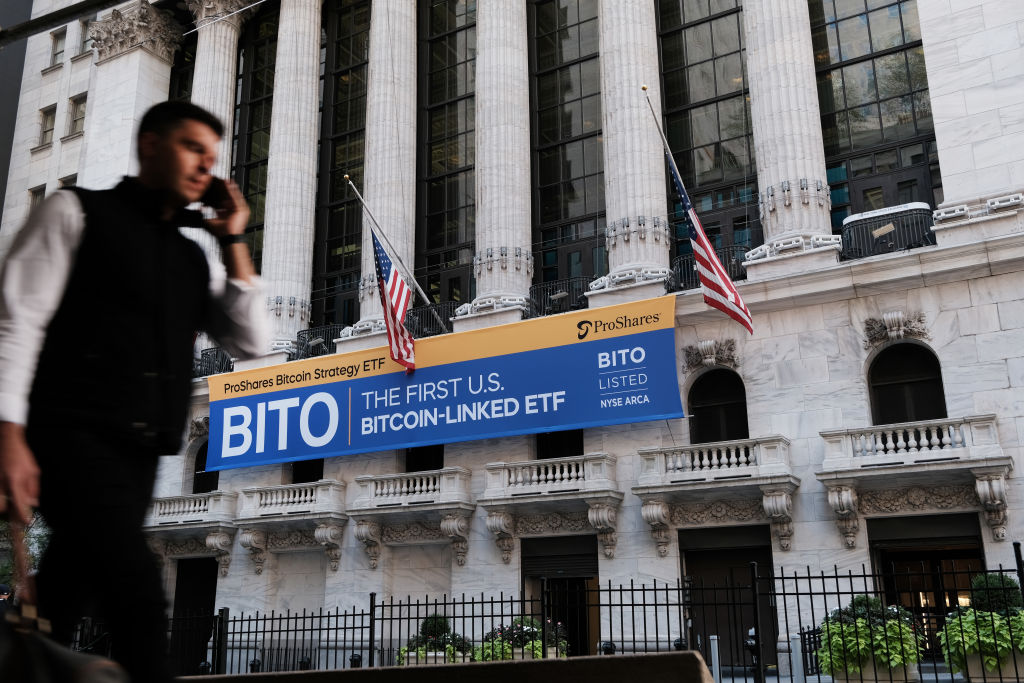First Bitcoin Futures ETF Rises In Trading Debut
ProShares Bitcoin Strategy ETF advances nearly 5% following its closely watched launch.
The first bitcoin-focused exchange-traded fund rose in its trading debut Tuesday after getting a warm reception from investors.
The ProShares Bitcoin Strategy ETF climbed most of the day, gaining nearly 5% to settle at US$41.94. About US$981 million of shares changed hands over the session, making it the second-most highly-traded ETF debut ever, according to Elisabeth Kashner, director of ETF research at FactSet.
The launch is being closely watched on Wall Street, where finding a way to sell securities linked to bitcoin has been a priority for many firms. Bethesda, Md.-based ProShares rang the bell at the New York Stock Exchange on Tuesday to celebrate the launch of its ETF, which goes by the ticker BITO and holds bitcoin futures contracts rather than the cryptocurrency.
“There are a multitude of investors who have brokerage accounts and are comfortable buying stocks and ETFs,” said ProShares Chief Executive Michael Sapir in an interview. “We think this will appeal to them.”
Among the fund’s first-day investors was Thomas Johnson, who is 33 years old and works in pharmaceutical sales in Orlando, Fla. Soon after the fund started trading, Mr. Johnson said he used about 15% of the assets in his retirement account to buy shares of the fund.
“I see cryptocurrencies as a whole as something that will outperform the stock market,” said Mr. Johnson.
He added that it was his first ever purchase of an ETF, although he started buying bitcoin a year earlier.
Other asset managers are expected to launch similar funds, including Valkyrie Investments, VanEck and others. But one of the biggest global asset-management firms, Invesco, on Monday put its bitcoin futures ETF on hold.
“We have determined not to pursue the launch of a Bitcoin futures ETF in the immediate near term,” an Invesco spokeswoman said in a statement. The firm said it is committed to working with its partner, Galaxy Digital Holdings, on an ETF that holds crypto rather than futures.
Invesco didn’t elaborate on the decision.
The firm amended its filing late Monday, pushing the fund’s effective date toward the end of the month rather than withdrawing it altogether, signalling the ETF might still launch later on.
Thomas Lee, a managing partner at research firm Fundstrat Advisors, said the ProShares ETF will enable more individuals to invest in bitcoin. He said assets in the fund could rise to as much as $50 billion from the $20 million the fund started with on Tuesday.
“This will drive higher asset prices via network effects,” Mr. Lee said. He said bitcoin could rise to $168,000 from a recent $64,000.
Bitcoin has climbed 48% since September, reflecting in part purchases driven by the prospective launch of the ProShares ETF and rivals.
The ETF came online following an eight-year effort by asset managers to create funds that hold actual bitcoins. The Securities and Exchange Commission, which hasn’t supported that approach because of concerns that bitcoin trading isn’t transparent enough to protect investors from fraud and manipulation, instead steered asset managers toward the creation of a bitcoin futures product.
Unlike digital currencies, futures trade on regulated venues such as the Chicago Mercantile Exchange.
Futures-based ETFs are sometimes hampered by discrepancies between the futures market and the underlying assets they track.
Asset managers say that is a trade-off some investors are likely willing to make to get exposure to crypto through the more-regulated futures market.
“That’s what I’m counting on. Other investors will see value in the ETF, or at least more of a safety net and be more willing to invest” in crypto, added Mr. Johnson.
Even with the promise of regulatory oversight, SEC Chairman Gary Gensler warned investors Tuesday that bitcoin futures remain just as risky as the cryptocurrency itself.
“It’s still a highly speculative asset class and listeners should understand that underneath this, it still has that same aspect of volatility and speculation,” Mr. Gensler said in a CNBC interview.
Reprinted by permission of The Wall Street Journal, Copyright 2021 Dow Jones & Company. Inc. All Rights Reserved Worldwide. Original date of publication: October 19, 2021.
 Copyright 2020, Dow Jones & Company, Inc. All Rights Reserved Worldwide. LEARN MORE
Copyright 2020, Dow Jones & Company, Inc. All Rights Reserved Worldwide. LEARN MORE
This stylish family home combines a classic palette and finishes with a flexible floorplan
Just 55 minutes from Sydney, make this your creative getaway located in the majestic Hawkesbury region.
More than one fifth of Australians are cutting back on the number of people they socialise with
Australian social circles are shrinking as more people look for ways to keep a lid on spending, a new survey has found.
New research from Finder found more than one fifth of respondents had dropped a friend or reduced their social circle because they were unable to afford the same levels of social activity. The survey questioned 1,041 people about how increasing concerns about affordability were affecting their social lives. The results showed 6 percent had cut ties with a friend, 16 percent were going out with fewer people and 26 percent were going to fewer events.
Expensive events such as hens’ parties and weddings were among the activities people were looking to avoid, indicating younger people were those most feeling the brunt of cost of living pressures. According to Canstar, the average cost of a wedding in NSW was between $37,108 to $41,245 and marginally lower in Victoria at $36, 358 to $37,430.
But not all age groups are curbing their social circle. While the survey found that 10 percent of Gen Z respondents had cut off a friend, only 2 percent of Baby Boomers had done similar.
Money expert at Finder, Rebecca Pike, said many had no choice but to prioritise necessities like bills over discretionary activities.
“Unfortunately, for some, social activities have become a luxury they can no longer afford,” she said.
This stylish family home combines a classic palette and finishes with a flexible floorplan
Just 55 minutes from Sydney, make this your creative getaway located in the majestic Hawkesbury region.






















